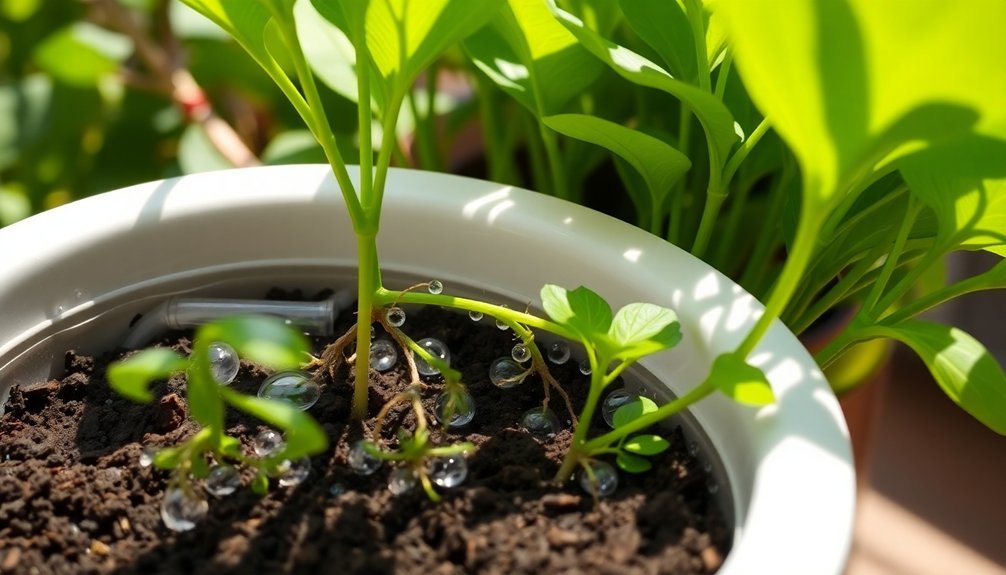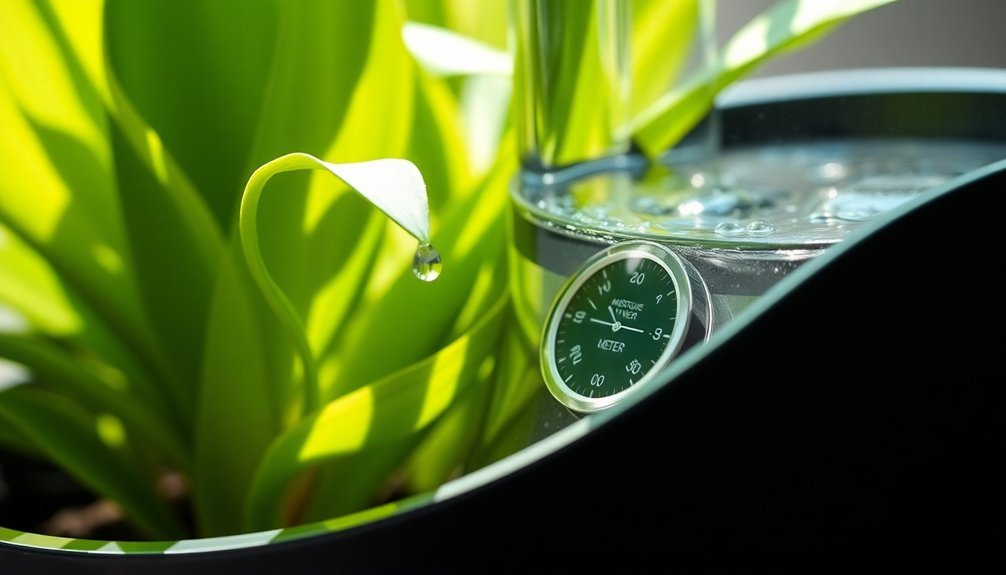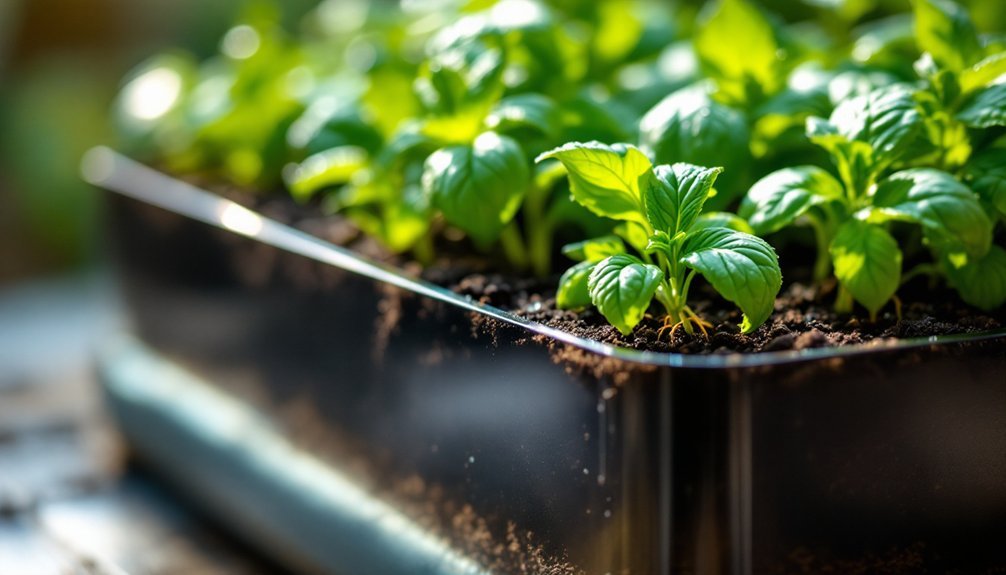Success with self-watering containers starts with selecting the right size pot for your plant's root system and ensuring proper drainage layers. You'll need to set up a reliable water reservoir, choose high-quality potting mix, and install an effective wicking system to draw moisture up to the roots. Don't forget to monitor water levels regularly and adjust based on your plant's needs. These essential components work together to create a thriving container garden system.
Selecting the Perfect Container Size and Material

When choosing a self-watering container, size and material selection play essential roles in your plant's success.
You'll need to match container size to your plant's root system – larger pots for extensive roots and smaller ones for compact plants. This guarantees proper growth and prevents overcrowding.
For materials, plastic self-watering planters offer durability and lightweight convenience, while ceramic options provide aesthetic appeal despite being heavier.
Look for containers with water level indicators to monitor moisture and multiple drainage holes to prevent waterlogging and root rot.
Don't forget to reflect on how the planter's design and aesthetics will complement your space. The right combination of functionality and style will enhance your plant care experience while creating an attractive display in your indoor or outdoor environment.
Creating Proper Drainage Layers for Self-Watering Success
While self-watering containers simplify plant maintenance, proper drainage layers form the foundation of their success. To create an effective system in your self-watering planters, start by laying small rocks or gravel at the base to prevent waterlogging and allow excess water to drain properly. This vital step helps avoid root rot and other moisture-related problems.
Place a layer of filter fabric above the drainage layer to keep soil from mixing with the gravel, maintaining the system's effectiveness.
You'll want to use well-draining soil enhanced with perlite or vermiculite for ideal moisture retention and aeration. Don't forget to monitor your drainage system regularly, ensuring the water reservoir flows freely and maintains a consistent moisture level.
These steps will promote healthy root growth and keep your plants thriving in their self-watering environment.
Mastering Water Reservoir Setup and Maintenance

A properly functioning water reservoir serves as the heart of any self-watering container system. To prevent leaks and maintain ideal plant health, you'll need to make sure your reservoir is correctly assembled and securely fitted.
Start by filling your container with a high-quality potting mix that provides both moisture retention and adequate drainage.
You'll need to monitor the water level regularly, typically refilling every 1-2 weeks to maintain consistent moisture for your plants.
Don't forget to clean the reservoir periodically to prevent algae growth and mineral buildup that could compromise your wicking system.
To keep your plants thriving, refresh the potting mix every year or two. This maintenance routine makes certain your soil remains fertile and your self-watering system continues functioning effectively throughout the growing season.
Choosing the Right Growing Medium and Wicking System
The right combination of growing medium and wicking material can make or break your self-watering container's success.
Select a high-quality potting mix that contains peat moss, coconut coir, or perlite to guarantee proper moisture retention and aeration. Your growing medium should strike a balance between holding water and providing adequate drainage to prevent root rot.
Choose a durable wick material, like cotton or synthetic fibers, that'll efficiently draw water from the reservoir to your plants' roots.
The wicking system needs to maintain consistent moisture levels without becoming clogged over time. You'll want to monitor both the growing medium and wick regularly to address any signs of nutrient depletion or moisture issues.
When you've got the right combination, your plants will thrive with reliable access to water and proper soil conditions.
Monitoring Water Levels and Adjusting for Plant Needs

Maintaining proper water levels in your self-watering container requires consistent monitoring and occasional adjustments based on your plants' changing needs.
You'll need to check your self-watering planters' water level indicators regularly to guarantee consistent access to moisture, with refills every 1-2 weeks.
Young plants often need more frequent monitoring than established ones, so adjust your schedule accordingly. During warmer months, you'll likely need to increase the frequency of refills due to higher water absorption.
To prevent overwatering, check the moisture level through drainage holes or use a moisture probe.
Watch for signs of stress like yellowing leaves or wilting, which signal it's time to modify your watering routine.
Frequently Asked Questions
What Is the Best Way to Use Self-Watering Pots?
You'll want to fill your pot with quality potting mix, plant carefully, and maintain the water reservoir. Check indicators regularly, clean wicks when needed, and refresh soil every couple years for ideal results.
Do Self-Watering Containers Really Work?
Yes, they'll work effectively if you use them correctly. You'll see healthier plant growth, consistent moisture levels, and reduced watering frequency. Your plants can thrive for weeks with proper setup and maintenance.
Should I Put Rocks in the Bottom of a Self-Watering Planter?
No, you shouldn't put rocks in your self-watering planter. They'll interfere with the wicking system and can create drainage problems. Instead, use quality potting mix or add perlite for better aeration and moisture control.
What Plants Do Not Do Well in Self-Watering Pots?
You'll want to avoid placing succulents, cacti, orchids, rosemary, and lavender in self-watering pots. These plants prefer drier conditions and can suffer from root rot with constant moisture exposure.
In Summary
Now you're ready to enjoy the benefits of your self-watering container garden. Don't forget to check water levels weekly and adjust based on your plants' needs. You'll find these containers save time, reduce watering stress, and help your plants thrive. If you've followed these five essential tips, you're well on your way to growing healthier, more productive plants with less daily maintenance.





Leave a Reply